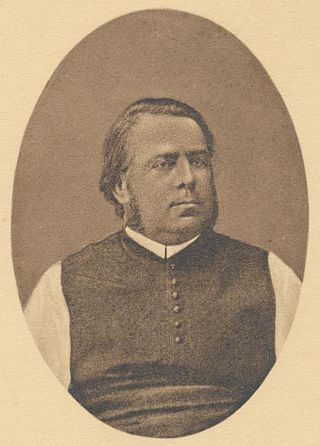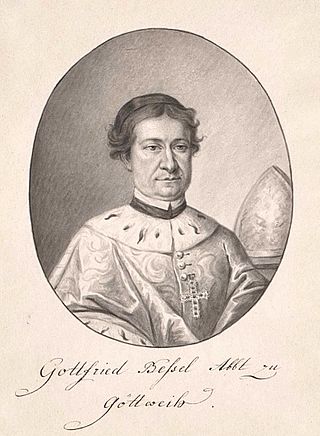
Chrysostomus Hanthaler (b. Ried, Upper Austria, 14 February 1690; d. in the Cistercian monastery of Lilienfeld in Lower Austria, 2 September 1754) was a Cistercian historian and numismatist.

Chrysostomus Hanthaler (b. Ried, Upper Austria, 14 February 1690; d. in the Cistercian monastery of Lilienfeld in Lower Austria, 2 September 1754) was a Cistercian historian and numismatist.
Having finished his theological studies in Salzburg, he made his profession in 1716 and subsequently devoted himself to historical research. [1]
He was part of the renewal in monastic scholarship initiated by the French Maurists. Closer to home, it was Bernard Pez in Melk and Gottfried Bessel in Göttweig who inspired Hanthaler. The archives and rich library in Lilienfeld offered a useful field for his activity.
On becoming librarian, Hanthaler made it his first task to compile a reliable catalogue and then collected all documents bearing on the history of Lilienfeld and of Austria. Copies and impressions of memorial tablets, seals, and coins were reproduced until his transcripts and compilations filled twenty-two folio volumes. From this matter he composed the Fasti Campililienses in two large volumes (Linz, 1747–1754): this monumental work was a history of Lilienfeld from the thirteenth century to the end of the Middle Ages, a history of the Babenberg dynasty, and also of the Steyer region. His death delayed the completion of his great compilation project. On the suppression of the monastery in 1789, the manuscript was brought to the Imperial Library at Vienna, but the copper plates and prints were sold. Subsequently both came into the hands of Abbot Ladislaus Pyrker, who published the last two volumes under the title of Fastorum Campiliensium Chrysostomi Hanthaler continuatio seu Recensus genealogico-diplomaticus archivi Campiliensis (Vienna, 1819–20), together with two appendices containing descriptions of the tombstones and extracts from the necrology of the monastery. [1]
Hanthaler left behind numerous other writings. These included:
Four chronicles of the Babenbergs, which Hanthaler listed in his Fasti in ancient sources, were in fact his own work. These were: [1]
Primate is a title or rank bestowed on some important archbishops in certain Christian churches. Depending on the particular tradition, it can denote either jurisdictional authority or (usually) ceremonial precedence.

The national flag of Austria is a triband in the following order: red, white, and red.

Heiligenkreuz Abbey is a Cistercian monastery in the village of Heiligenkreuz in the southern part of the Vienna woods, c. 13 km north-west of Baden in Lower Austria. It is the oldest continuously occupied Cistercian monastery in the world.

Frederick II, known as Frederick the Quarrelsome, was Duke of Austria and Styria from 1230 until his death. He was the fifth and last Austrian duke from the House of Babenberg, since the former margraviate was elevated to a duchy by the 1156 Privilegium Minus. He was killed in the Battle of the Leitha River, leaving no male heirs.
JohannesBusch was a major reformer and provost of a community of Canons Regular. He was associated with the Brethren of the Common Life.

Ekkehard of Aura was the first Abbot of Aura from 1108. It is thought that Ekkehard was a member of the Bavarian aristocracy.

Carlo Giuseppe Imbonati ("Imbonatus") was a Cistercian scholar who was active during the last half of the 17th century. He spent much of his career in Rome and rose to the title of abbot. He was a theologian and a Hebrew scholar who wrote prolifically in his fields. The last known references to the man are dated in 1696.
John of Viktring was a late medieval chronicler and political advisor to Duke Henry of Carinthia.
Antoine Henri de Bérault-Bercastel (1720–1794) was a French priest and Catholic historian.
Helinand of Froidmont was a medieval poet, chronicler, and ecclesiastical writer.

The Diocese of Linz is a Latin Church diocese of the Catholic Church. It is a suffragan of the Archdiocese of Vienna, Austria.

Leopold Janauschek was an Austrian Cistercian historian.
Hugh or Hugo was a Benedictine monk and historian. He served as abbot of Flavigny from 1097 to 1100.
François Clement was a French historian and member of the Benedictine Congregation of St. Maur.

Jacques Crétineau-Joly was a French Catholic journalist and historian, known both for his political activism and for his extensive histories of the Jesuits.
Henry of Rebdorf is the name given to the alleged author of an imperial and papal chronicle of the thirteenth and fourteenth centuries. The only connexion between the chronicle to which the name of Henry of Rebdorf has been attached and the foundation of the Augustinian canons at Rebdorf, near Eichstätt, Bavaria, lay in the fact that the first editor of the said chronicle published it from a manuscript preserved there, and later taken to the Bibliothèque Nationale in Paris, while other manuscripts, displaying no essential points of difference, are known to exist in Klosterneuburg Monastery and in the Hofbibliothek in Vienna.

Johann Franz Bessel was a German Benedictine abbot and historian.

Johann Ladislaus Pyrker (von Oberwart)(von Felsö-Eör) (Hungarian: felsőőri Pyrker János László; 2 November 1772 in Nagyláng, Soponya, near Székesfehérvár, Hungary – 2 December 1847 at Vienna) was a Hungarian Cistercian abbot, archbishop and poet.

Bernhard Pez was an Austrian Benedictine historian and librarian.

Ernest Johann Nepomuk, Imperial Count von Herberstein, was the first bishop of the diocese of Linz from 1785 to 1788.